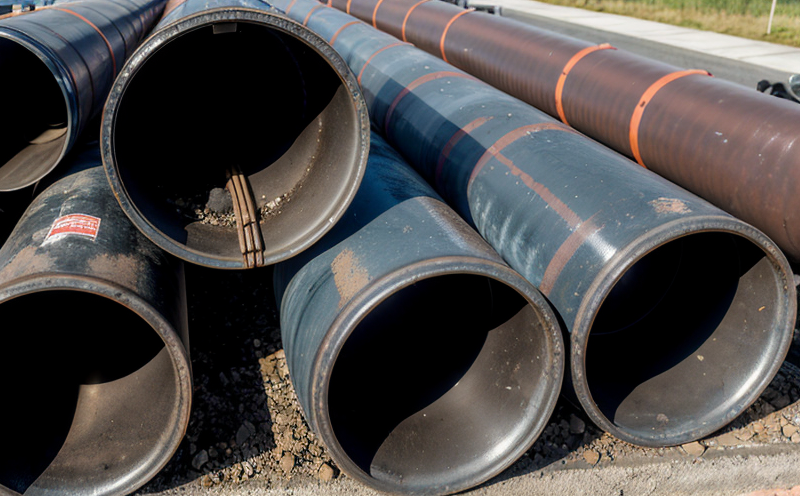DIN 19534 Testing of Plastic Tubes for Wastewater
The DIN 19534 standard is a critical document that outlines the requirements for the testing and approval of plastic tubes used in wastewater systems. This standard ensures that the materials and components used are safe, reliable, and suitable for the harsh conditions found within wastewater treatment facilities.
The primary focus of this test is on determining the resistance to stress cracking, which can occur due to the aggressive nature of waste water containing various chemicals and biological agents. The standard applies specifically to plastic tubes intended to convey wastewater under a pressure range from 0 to 15 bar at temperatures between -20°C and +60°C.
The testing procedure involves subjecting samples to cyclic loading, typically over a period of several weeks or months, depending on the expected service life. This process simulates real-world operating conditions to ensure that the tubes can withstand long-term use without degradation.
During the test, the specimens are subjected to alternating loads and temperatures, which mimic the stress and strain encountered in wastewater systems. The results of these tests provide valuable data regarding the performance characteristics of the plastic material used in the construction of the tubes.
The DIN 19534 protocol also includes specific instructions for sample preparation, including dimensions, surface finish, and orientation within the test apparatus. These details are crucial to ensuring consistent and accurate testing results across different manufacturers and laboratories.
| Test Parameter | Description |
|---|---|
| Pressure Range | 0 to 15 bar |
| Temperature Range | -20°C to +60°C |
| Loading Cycles | Cyclic loading over several weeks or months |
| Sample Dimensions | Defined by DIN 19534 |
The results of the DIN 19534 tests are typically reported in terms of stress-crack resistance and material durability. These reports serve as a critical tool for quality managers, compliance officers, and R&D engineers to ensure that products meet regulatory requirements and perform reliably under real-world conditions.
- Ensures safe and reliable performance of plastic tubes used in wastewater systems.
- Provides data on stress-crack resistance under cyclic loading and temperature variation.
- Helps manufacturers comply with international standards for environmental protection.
Benefits
The DIN 19534 testing ensures that plastic tubes used in wastewater systems are safe, reliable, and capable of long-term performance. This standard benefits several key stakeholders:
- Manufacturers: Compliance with DIN 19534 ensures that products meet stringent quality standards, enhancing brand reputation.
- Quality Managers: The test results provide critical data for product development and improvement.
- Compliance Officers: It helps in ensuring regulatory compliance, reducing the risk of non-compliance penalties.
- R&D Engineers: Detailed testing data aids in advancing material science and engineering practices.
The standard also contributes to environmental sustainability by promoting the use of materials that can withstand harsh conditions without breaking down or leaching harmful substances into the environment.
Environmental and Sustainability Contributions
DIN 19534 testing is crucial for ensuring that plastic tubes used in wastewater systems are environmentally friendly. By adhering to this standard, manufacturers can ensure that their products do not contribute to environmental degradation or pollution.
The use of DIN 19534 compliant materials helps reduce the need for frequent replacements due to stress cracking and failure under harsh conditions. This, in turn, reduces waste generation and minimizes the environmental impact associated with production and disposal of non-compliant products.
Moreover, by ensuring that plastic tubes meet the stringent requirements set forth by DIN 19534, manufacturers can contribute to the overall sustainability goals of wastewater treatment facilities. This includes reducing energy consumption during operation and minimizing greenhouse gas emissions associated with the use of inefficient materials.
Use Cases and Application Examples
DIN 19534 testing is widely used in wastewater treatment facilities where plastic tubes are employed for conveying wastewater. Here are some specific applications:
| Application | Description |
|---|---|
| Municipal Wastewater Plants | Testing ensures that the pipes can withstand the high pressures and temperatures encountered in municipal wastewater systems. |
| Industrial Waste Systems | The test verifies that industrial waste pipes are capable of handling aggressive chemicals present in industrial effluents. |
| Rural Sewage Networks | DIN 19534 ensures that rural sewage network pipes can operate reliably under varying environmental conditions. |
These applications highlight the importance of DIN 19534 in ensuring the integrity and longevity of plastic tubes used in wastewater systems. The tests provide critical data that supports informed decision-making by quality managers, compliance officers, R&D engineers, and procurement specialists.
- Municipal Wastewater Plants
- Industrial Waste Systems
- Rural Sewage Networks





